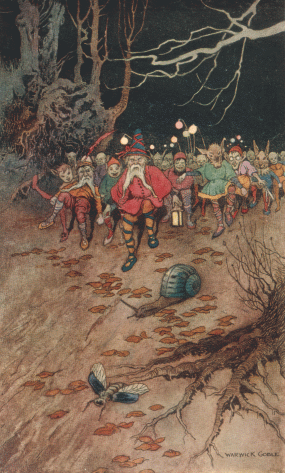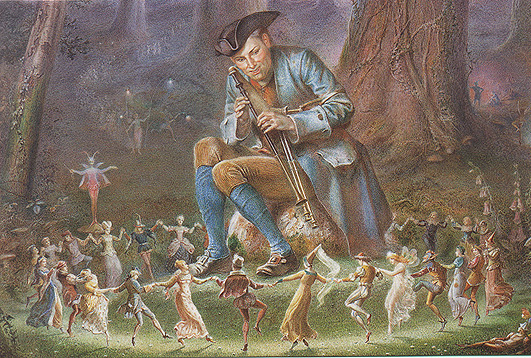Having dealt with Tolkien’s Lesser Tales over the last month, there was really only one piece of Tolkien’s fiction that we could possibly turn to as a postscript to this series – what may very well be the Least Tale of Tolkien, as it were.
Mention ‘Goblin Feet’ to a Tolkien lover, and you’ll get one of two reactions. The first (and much more common) is likely bafflement, a “huh?” and subsequent inquiry as to whether this is some sort of evidence about the origin of Orcs? The rarer, and desired, reaction, is a wry chuckle and a raise of the eyebrow, a sudden mutual sharing of some private joke.
Goblin Feet bears two honours – it is the first published work of fiction in Tolkien’s entire oeuvre, having been written in 1915 and published in several anthologies long before a hobbit lived in a hole in the ground.
The other honour, of course, is that it is the only work of Tolkien’s that the man himself is on the record as having absolutely hated.
Written around the same time that Eärendil first appeared on the horizon of Tolkien’s sky, Goblin Feet is representative of everything concerning then-contemporary fantasy that the Professor would come to loathe. As he memorably grouches in On Fairy Stories:
As for diminutive size: I do not deny that the notion is a leading one in modern use. I have often thought that it would be interesting to try to find out how that has come to be so; but my knowledge is not sufficient for a certain answer. Of old there were indeed some inhabitants of Faerie that were small (though hardly diminutive), but smallness was not characteristic of that people as a whole. The diminutive being, elf or fairy, is (I guess) in England largely a sophisticated product of literary fancy. It is perhaps not unnatural that in England, the land where the love of the delicate and fine has often reappeared in art, fancy should in this matter turn towards the dainty and diminutive…Yet I suspect that this flower-and-butterfly minuteness was also a product of “rationalisation,” which transformed the glamour of Elfland into mere finesse, and invisibility into a fragility that could hide in a cowslip or shrink behind a blade of grass…In any case it was largely a literary business in which William Shakespeare and Michael Drayton played a part. Drayton’s Nymphidia is one ancestor of that long line of flower-fairies and fluttering sprites with antennae that I so disliked as a child, and which my children in their turn detested.
On Fairy Stories, by J.R.R. Tolkien
Yet Goblin Feet is just such a story, the sort of vaguely fuzzy twee cutesy Victorian twaddle that Tolkien himself protests against and reports having disliked in his youth. It is a poem that features blundery beetle things, the tiny horns of enchanted leprechauns, and (of course) the sound of happy little feet…it is, in short, incredibly light and frivolous. And, in contrast with Tolkien’s other lighter and child-friendly works, such as Roverandom or even Farmer Giles of Ham, there’s nearly nothing to recommend it as being of great worth. The poetry itself is perfectly competent, but not extraordinary. The list of characters and wonders reads less as being a scene of wonder, rather being a laundry list of pretty words. There’s no sense of Faery as Tolkien himself would come to describe it, though there is quite a lot of fairy.

Nearly nothing to recommend it, I said. Not nothing.
The poem itself was written by Tolkien for his then-fiancée Edith, who was reportedly fond of ‘little elfin things’, and it is (to its credit) at least a fair example of things that are both little and elfin. It also isn’t so atypical of Tolkien’s early writings in general (though it does lack the depth and sense of profundity that I would argue even those very early writings generally achieved), and probably would’ve faded into obscurity were it not for the fact that Tolkien submitted it (along with other poems) for consideration of publication, and it (though not the others) was duly published as part of an anthology. And republished. And republished yet again.
By the time Tolkien’s next work of fiction, The Hobbit, was published, Goblin Feet had in fact been included in at least five separate anthologies of poetry, most of them being oriented towards children, and though it certainly did not make Tolkien a household name, it is amusingly likely that the poem itself was fairly broadly read. This, perhaps, goes some way toward explaining the report that when Tolkien was asked if he would consider yet another republication of the poem in a 1971 anthology, he declined with typical Tolkien tact.
I wish the unhappy little thing, representing all that I came (so soon after) to fervently dislike, could be buried for ever.
‘The Cottage of Lost Play,’ from The Book of Lost Tales, Volume I – J.R.R. Tolkien, ed. Christopher Tolkien
That being said, there are also certain Tolkienisms that are already apparent in this youthful work. Silver and grey are used to describe the fairy cavalcade and their road, and the poem dwells upon nature and music – both features of Tolkien’s later writing. But I actually want to discuss the very last stanza of the poem – or really, the last line of the last stanza.
O! the warmth! O! the hum! O! the colours in the dark!
Goblin Feet, by J.R.R. Tolkien
O! the gauzy wings of golden honey-flies!
O! the music of their feet – of their dancing goblin feet!
O! the magic! O! the sorrow when it dies.
And…that’s how it ends. O! the sorrow when it dies. That’s the very last line – no promise that the merry goblins will ever be seen again, no final little outburst of joy. It’s easy to ignore it, but I think it is a distinctly bleak moment, and more so when it is dwelt upon. The poem, even this light and fluffy poem, ends in darkness and bittersweetness, hallmarks of Tolkien’s more celebrated later output. It’s terribly striking in this context, and is (I think) quite revealing of how even that young Tolkien viewed the ephemeral and intangible joy of Faery.
In discussing Smith a few weeks ago, I made mention of the various attempts to find some sort of allegorical or symbolic meaning to the work. One (rather common) reading is to understand the figure of Smith as being semi-autobiographical. As a young man, he is captured by the joys of Faery. Through his youth and manhood, he wanders its lands, whilst also practising his trade and raising a family in the World. Then, as he grows older, passage to Faery is taken from him – he does not forget it, and he sees it being passed on to another child but he, now a grandfather, must accept that Faery is gone from him now, and anything he had wished to achieve in that land is forever lost.
Smith was published in 1967, six years before Tolkien died, and was his last published work of fiction. It is not difficult to imagine an old and weary Tolkien – finally coming to terms with the fact that the Legendarium that has formed his life’s work will never be completed to his own satisfaction – ‘giving up the star’, as it were. But I protested against allegorical readings of Smith in that post, and I will do so again here. I do not doubt that Smith is autobiographical, but in terms of ‘feeling’ rather than in any sort of mapping upon historical detail. Smith is autobiographical in that he is, like Tolkien, a wanderer in Faery – no more, no less.
And, strangely, Goblin Feet is a prime component of my defence of this reading. The autobiographical reading of Smith usually leans heavily upon Tolkien’s perspective as an old man – yet here, in his early twenties, Tolkien is referencing that exact sense of loss and bereavement in a silly little poem. Even then, Tolkien was fully aware that the magic of Faery is no permanent or reliable thing – whether one loses the goblins or not has nothing to do with age, and everything to do with inevitability. Man cannot tarry forever in Faery, even in so silly and shallow a fairy realm as that in which the enchanted leprechauns blow their horns.
O! the sorrow when it dies is such a strikingly Tolkienish line to me, and I find it fascinating that Tolkien is already aware of those themes of loss and melancholy that would come to define much of his literary output. The poem may not amount to much as a whole, but it seems to me that it does betray Tolkien’s sensibilities as being very, very deeply rooted within him. Before he was married, before he fought in WWI, before he taught, before he developed his mythology, and well well before he reached the end of his life, Tolkien was already keenly aware that the joys of Faery are not permanent things, but ghostly and inevitably slipping away, and that their passing is to be mourned.
Goblin Feet – it might not be great, and he might have regretted its publication, but it’s still definitely Tolkien.
~~~~~~~~~~~~~
Thanks for reading – feel free to check out anything else you may be interested in on the blog, there’s plenty more to discover! Follow me on Facebook and on Twitter to stay up to date with The Blog of Mazarbul, and if you want to join in the discussion, write a comment below or send an email. Finally, if you really enjoyed the post above, you can support the blog via Paypal, and keep The Blog of Mazarbul running. Thanks for reading, and may your beards never grow thin!
